Go Wild Outdoors in the Keys
March 10, 2016 at 3:39 pm | Posted in Uncategorized | Leave a commentTags: Crocodile Lake, florida keys, Great White Heron, Guy Harvey, Guy Harvey Outpost, Key Deer, Key Largo, Key West, Outdoor Fest

By Sue Cocking, Guy Harvey Outpost staff writer
scocking@guyharveyoutpost.com
When most people visit the Florida Keys, fishing and diving are foremost in mind. But there is a heck of a lot more to take in on the wild side of this 110-mile long island chain than visitors might think: four national wildlife refuges with a cornucopia of animals, birds, plants and insects to observe up close.
From March 17-20, families, nature photographers, birders and other outdoors enthusiasts are invited to the inaugural Outdoor Fest–four days of mostly free events showcasing unique flora and fauna from Key Largo to Key West.
Attendees will be able to take a behind-the-scenes kayak tour of the Crocodile Lake National Wildlife Refuge in Key Largo; observe beautiful sea birds at the Great White Heron National Wildlife Refuge in the Lower Keys; watch miniature endangered Key deer at the refuge named for the species on Big Pine Key; and go birding, sailing, snorkeling and kayaking in the Key West National Wildlife Refuge.
Other activities include a 12-mile natural history bike hike on Big Pine; geocaching; a 5K “Run with the Deer”; art and photography workshops; art and craft fair; walking tours; and a nighttime ‘moth-whisperer’ event.
The event is presented by the U.S. Fish & Wildlife Service’s Florida Keys National Wildlife Refuges Complex and its booster organization, the Friends and Volunteers of Refuges (FAVOR).
“There’s so much overlap of government land down here,” said Kristie Killam, a park ranger with the Refuges Complex. “We wanted to create an identity for ourselves. We hope this is a way to educate people on how magnificent these four chunks of land are.”
Refuge biologists will introduce visitors to rarely-seen insects, reptiles and birds, including a tour of nest boxes erected for the endangered Key Largo wood rat. And Killam especially recommends the evening presentations.
“All these night creatures will come in that you never get to see,” she said. “It’s amazing what you see that you never thought of.”
Additional activities are planned before and after the festival. For a complete schedule and to register for events, go to: www.favorfloridakeys.org/outdoor-fest.
*****************
Sue Cocking chronicles the Guy Harvey Outpost travel and adventure experience in regular blog posts on GuyHarveyOutpostNews.com/. For 21 years, Cocking covered the full spectrum of outdoors adventure opportunities in South Florida and beyond for the Miami Herald, including fishing, diving, hunting, paddling camping, sailing and powerboat racing. She is a certified scuba diver and holder of an IGFA women’s world fly fishing record for a 29-pound permit.
**********
Share your photos, videos and experiences with Guy Harvey Outpost by hash tagging #OutpostAttitude to all of your social media posts.
Fishing the Pelagic Rich Pacific with Guy Harvey Outpost
March 9, 2016 at 2:10 am | Posted in Uncategorized | Leave a commentTags: Guy Harvey, Guy Harvey Outpost, marlin, Panama, Sportfishing, yacht charter
 By Sue Cocking, Guy Harvey Outpost staff writer
By Sue Cocking, Guy Harvey Outpost staff writer
scocking@guyharveyoutpost.com
Steve Schniedman, experienced Florida offshore fisherman, has traveled the world, catching and releasing blue, white, and striped marlin. But the fourth element of the superfecta– black marlin– eluded him until recently when he visited the pelagic-rich Pacific waters off Panama with several members of the Guy Harvey Outpost Resorts team.
Fishing aboard a 66-foot Buddy Davis yacht piloted by the crew of Panama Yacht and Fishing Charters– a Guy Harvey Outpost Expedition outfitter– Schniedman hooked a black estimated at between 300 and 400 pounds using a small live tuna for bait.
“It was the fight of a lifetime– a crazy fight,” Schniedman said. “He took a lot of line. We were full-throttle backing down just to keep up with him. He jumped five or six times.”
Schniedman had his hands full– literally–fighting the huge billfish on 50-pound tackle, but he eventually reeled it close enough for the crew to unhook and release it.
“The best trip I’ve ever been on,” he said afterward.
Not only was the fishing spectacular, according to Schniedman, but the experience of living aboard a 98-foot luxury Knight and Carver mother ship was first-rate.
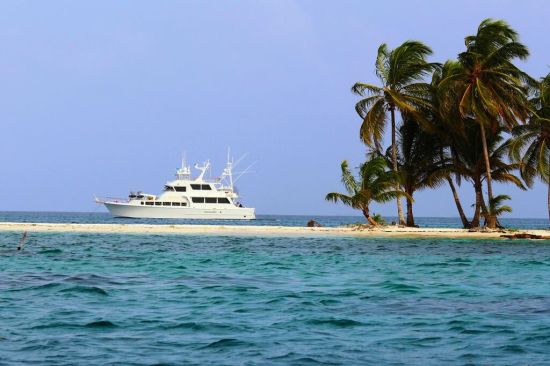
“The mother ship we lived on was absolutely beautiful,” he said. “The crew, the food, the chef–everything was five-star. I’d certainly go down and fish on that boat again.”
A typical day involved waking early, catching live bonitos and skipjacks along the Zane Grey Reef, then trolling the livies along the reef for the blacks. When the sun grew warmer, the crew headed to the deeper offshore waters of the Hannibal Bank. At sundown, the boat made another pass along the reef before returning to the mother ship– “a floating luxury lodge”, according to GHO president Mark Ellert.
In addition to Schniedman’s black marlin, the GHO party of Ellert, sportfishing director Cliff Jensen, and their friend Phil Schoonover caught numerous huge dolphin fish, or mahi. Jensen caught his first-ever dog-toothed tuna. Schoonover caught and released several trevally up to 15 pounds on fly rod.
The fishing wasn’t the only draw, according to the group. One evening, the mother ship was visited by a party of villagers in dug-out canoes laden with handmade arts and crafts.
“A virtual shopping center,” Ellert marveled, adding that everyone bought some treasures to take home.
While the black marlin season is winding down along Panama’s Pacific coast, spring and summer present bountiful opportunities for catching large yellowfin tuna and Cubera snapper. To book your adventure, visit http://bit.ly/1PJkI2b or call Jensen at 954-243-1178 or email cjensen@guyharveyoutpost.com.
Better hurry up or Schniedman might elbow you out of the way.
*************
Sue Cocking chronicles the Guy Harvey Outpost travel and adventure experience in regular blog posts on GuyHarveyOutpostNews.com/. For 21 years, Cocking covered the full spectrum of outdoors adventure opportunities in South Florida and beyond for the Miami Herald, including fishing, diving, hunting, paddling camping, sailing and powerboat racing. She is a certified scuba diver and holder of an IGFA women’s world fly fishing record for a 29-pound permit.
**********
Share your photos, videos and experiences with Guy Harvey Outpost by hash tagging #OutpostAttitude to all of your social media posts.
Get the Stu Apte Edge in the Blazing Mako
March 3, 2016 at 8:34 pm | Posted in Uncategorized | Leave a commentTags: backcountry fishing, Blazing Mako, florida keys, Guy Harvey, Guy Harvey Outpost, Stu Apte
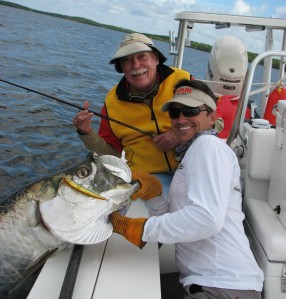 By Sue Cocking, Guy Harvey Outpost staff writer
By Sue Cocking, Guy Harvey Outpost staff writer
scocking@guyharveyoutpost.com
A little over one year ago at the 2015 Miami International Boat Show, a handful of luminaries from the sport fishing industry, including Dr. Guy Harvey, assembled in a meeting hall to roast Stu Apte– then 84 years old. They cracked goofy and ribald jokes about his age, health, crankiness, fishing abilities, and anything else they could think of in the way of deprecating humor. Apte was a good sport throughout and even came back with some witty barbs of his own.
Fast-forward to March 2016 and you will find that the leading pioneer of light tackle and fly rod fishing in the Florida Keys and beyond has slowed down not a whit. The 85-year-old former fishing guide and airline pilot recently won one of the top awards in a prestigious Islamorada back country fishing tournament competing against anglers one-quarter his age. He’s introducing a new line of signature fly rods from 4- to 13-weight by Tycoon Tackle and new signature fly reels by 3-TAND. He’ll celebrate his 15th wedding anniversary with wife Jeannine in May, followed by a ten-day fishing trip to Cuba.
But Apte will be back in Islamorada just in time to fish with YOU (!!!) –in the Blazing Mako Tournament and Festival on Father’s Day weekend June 16-19 at the Islander, a Guy Harvey Outpost Resort.
The Blazing Mako is conducting an auction where the highest bidder will get to fish the one-day back country tournament June 18 with Apte and one of his favorite Islamorada guides, veteran captain Steve Thomas. With Thomas poling the skiff and pointing out fish, and Apte coaching (or not), your chances of winning cash and trophies in this catch-measure-photograph-release competition increase exponentially.
CLICK HERE TO BID ON THE STU APTE AUCTION!
With optimum fishing conditions expected in June, you should be able to find plenty of tarpon, snook, and other inshore species, according to Apte, who promises not to be a fish hog.
“They are going to be on the casting platform,” Apte said of the auction winner. “I’m going to help them. I’ll back them up with a spinning rod. If they want me to demonstrate on fly rod, I’ll do it. Whatever makes them happy. I’m really excited.”
Money raised from the auction will benefit marine science scholarships at Nova Southeastern University’s Halmos College of Natural Sciences and Oceanography through the Guy Harvey Ocean Foundation.
‘Fish whisperer’ won’t be Apte’s only function at the Blazing Mako. He’ll join other top local guides at a seminar at Angler House Marina, where inshore tournament boats will launch. And he will dedicate his signature cocktail — the Stu Apte Rum Dumb Boogie Punch–as the event’s official beverage.
In the unlikely event that you are not familiar with Apte’s fishing credentials:
-Since the 1950’s, he has held more than 44 saltwater light tackle and fly rod world records.
– He’s a member of the Fishing Hall of Fame (1969); the International Game Fish Association Hall of Fame (2005); and the Fly Fishing Hall of Fame (2012).
– His Stu Apte tarpon fly adorned a U.S postage stamp in 1991.
-He has written numerous fishing articles for national and regional publications; published three books; and appeared in scores of television fishing programs.
Best of all, Apte developed the “down-and-dirty” style of fighting large tarpon– an effective technique to shorten the battle by pulling the fish in the opposite direction of where it wants to go.
Be the top bidder, and learn this and other tricks from the master himself.
Don’t miss out on this chance to fish with one of the world’s true mater anglers – Stu Apte! Go HERE now to bid!
******************
Sue Cocking chronicles the Guy Harvey Outpost travel and adventure experience in regular blog posts on GuyHarveyOutpostNews.com/. For 21 years, Cocking covered the full spectrum of outdoors adventure opportunities in South Florida and beyond for the Miami Herald, including fishing, diving, hunting, paddling camping, sailing and powerboat racing. She is a certified scuba diver and holder of an IGFA women’s world fly fishing record for a 29-pound permit.
**********
Share your photos, videos and experiences with Guy Harvey Outpost by hash tagging #OutpostAttitude to all of your social media posts.
Bowfishing for Tilapia in the Everglades
March 2, 2016 at 1:26 pm | Posted in Uncategorized | Leave a commentTags: bowfishing, Everglades, Guy Harvey Outpost, tilapia
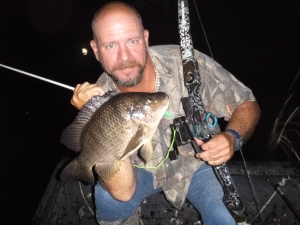 By Sue Cocking
By Sue Cocking
scocking@guyharveyoutpost.com
Captain Jason Peters stands at the helm of his airboat, sweeping the clear, shallow slough with the beam of his headlamp as his friend captain Bill Lepree wields a longbow from the bow. Suddenly, the light catches a small, brown torpedo-like shape just beneath the surface.
Lepree nocks an arrow, draws back and shoots, missing the target entirely.
“Aw, too high,” Peters coaches. “Aim low — shoot way under them because of the refraction of the water.”
Peters and Lepree were hunting blue tilapia– a tasty, exotic freshwater fish found in lakes, rivers and marshes throughout Florida. Archery and gigging are about the only effective methods of taking them because they eat mostly algae and other organisms that grow on water plants, and are not usually susceptible to hook-and-line fishing.
The hunting grounds this night were the open sloughs in the Everglades near Sawgrass Recreation Area in western Broward County. From December through March when water levels are lower, tilapia assemble like herds of miniature cattle in the shallows. Night hunting is preferred because the fish are much less wary than in daytime. But as Lepree discovered, nailing one is still a challenge– even under cover of darkness.
“If I had to do this for food, I’d be screwed,” Lepree said after failing to nail some 20 tilapia.
Peters got Lepree to within a couple of feet of his targets, but his shots either were too low or too high. Still, the newbie fish hunter relished the challenge.
“It’s hard,” Lepree said. “The hardest part is the depth perception– trying to shoot something underwater from the surface. Plus the fish are moving and the boat is moving and that makes it challenging.”
“A crazy mind game,” Peters agreed.
The pair spotted lots of other aquatic creatures in the headlamp as they cruised the flats: a 10-foot alligator, several frogs, grass carp, bass, bluegill, catfish, and mudfish.
Finally, Lepree managed to shoot a mudfish, but it wriggled off the shaft and threw a sizeable wake as it porpoised away on the surface.
“Wow! That made my night,” the veteran sportfishing captain said.
Peters took over the longbow and shot a handful of tilapia up to about five pounds. He also gigged a frog and a bullhead catfish. The hunters could have harvested as many tilapia as they wanted because the species is not native to Florida, and therefore not subject to size or bag limits or fishing seasons.
Blue tilapia come from North Africa and the Middle East, brought here in the 1960s as an experiment in sport angling and to help control the spread of some aquatic plants. But those plans went awry when some ‘bandit’ anglers took the fish from their inland enclosure and released them into the wild. Now they are widespread in south and central Florida. The state record is 9.38 pounds and was taken in the St. Lucie River in 2010. Fish in the two- to four-pound range are common.
Peters, who operates JP Outfitters guide service in Hollywood, has developed a thriving business guiding customers on night-hunting expeditions for tilapia. Even though Lepree wasn’t successful, he said he’d like to try again.
“That was really cool,” he said. “I’d like to bring my son.”
***************
Sue Cocking chronicles the Guy Harvey Outpost travel and adventure experience in regular blog posts on GuyHarveyOutpostNews.com/. For 21 years, Cocking covered the full spectrum of outdoors adventure opportunities in South Florida and beyond for the Miami Herald, including fishing, diving, hunting, paddling camping, sailing and powerboat racing. She is a certified scuba diver and holder of an IGFA women’s world fly fishing record for a 29-pound permit.
**********
Share your photos, videos and experiences with Guy Harvey Outpost by hash tagging #OutpostAttitude to all of your social media posts.
Somewhere Under the Rainbow
February 25, 2016 at 8:37 pm | Posted in Uncategorized | Leave a commentTags: Crystal River, Dennellon, Guy Harvey, Guy Harvey Outpost, Plantation, Rainbow River, snorkel
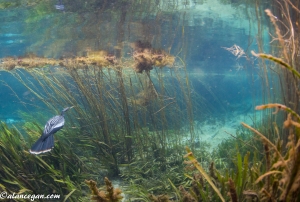 By Sue Cocking, Guy Harvey Outpost staff writer
By Sue Cocking, Guy Harvey Outpost staff writer
scocking@guyharveyoutpost.com
[Dunnellon, FL–] Drifting at a speed of 1 1/2 knots downstream in west-central Florida’s Rainbow River, I am blown away by the clarity of the water, the shimmering kelly-green eelgrass dotting the bottom and, most of all, by the antics of a cormorant.
Through my dive mask, I watch raptly as the black water bird with the curved yellow beak plunges ten feet deep, churning up the sand and parting the thick grass blades in a hunt for food. To my left, a terrified sunfish darts away unharmed, and a few seconds later, the cormorant returns to the surface empty-beaked.
Two feet apart, we look at each other and the unperturbed hunter makes another dive, still unsuccessful. I drift with him for a good eighth of a mile, but he never spears a fish. Maybe the black shadow of my thick wetsuit is scaring away his prey, and he leaves me behind. But watching him was fun while it lasted.
A cornucopia of wonders awaits just about anyone who snorkels or dives this scenic watercourse. The Rainbow emanates from a second-magnitude spring in the state park that bears its name that, together with numerous smaller springs, generates more than 450 million gallons per day of nearly invisible, 72-degree water. With a maximum depth of 25 feet, it flows for about 5 1/2 miles before joining the larger, tannic-brown Withlacoochee River.
My friend Kyle Stewart and I began our snorkel float about a half-mile downstream from the park– (boats are not permitted in the headspring)– guided by captain Ross Files on a pontoon boat from the dive shop at Plantation on Crystal River. Files kept the boat ahead of us as we drifted, flying a dive flag to warn approaching boaters– of which there were very few.
What fun! We passed fat largemouth bass and colorful bream hovering around numerous tiny spring vents that look like miniature geysers erupting on the sandy bottom.
At the major spring heads, I could feel the warmth of their deep underground sources as I drifted overhead. At one spot, at least a dozen pointy-nosed alligator gar hovered. And we floated over a sunken palm tree that Files said was reputed to have been used by actor Johnny Weissmuller as a diving platform in the “Tarzan” movies of the 1940s.
Just before the take-out site at the K.P. Hole Park boat ramp, we spied a gigantic alligator snapping turtle sitting placidly in the eel grass.
Unlike many spring-fed rivers in this region, no manatees show up in the Rainbow seeking refuge from cold Gulf waters in the winter. That’s because an old lock system in the waterway between the river and Gulf block their access. In four trips here, I’ve seen exactly one alligator and it was very small and swam away in terror.
Winter is the best time to do a drift dive or snorkel because the wildly-popular practice of tubing is prohibited from October through March.
Befitting its jeweled status, the Rainbow is designated a national natural landmark, an aquatic preserve and an outstanding Florida waterway.
Plan to visit now before the springtime crowds arrive.
******************
Sue Cocking chronicles the Guy Harvey Outpost travel and adventure experience in regular blog posts on GuyHarveyOutpostNews.com/. For 21 years, Cocking covered the full spectrum of outdoors adventure opportunities in South Florida and beyond for the Miami Herald, including fishing, diving, hunting, paddling camping, sailing and powerboat racing. She is a certified scuba diver and holder of an IGFA women’s world fly fishing record for a 29-pound permit.
**********
Share your photos, videos and experiences with Guy Harvey Outpost by hash tagging #OutpostAttitude to all of your social media posts.
Spring Into Adventure with Mermaids and Manatees
February 23, 2016 at 2:54 pm | Posted in Uncategorized | Leave a commentTags: Crystal River, Guy Harvey, Guy Harvey Outpost, Homosassa Springs, mermaids, Weeki Wachee, Withlacoochee State Trail
 By Sue Cocking, Guy Harvey Outpost staff writer
By Sue Cocking, Guy Harvey Outpost staff writer
scocking@guyharveyoutpost.com
[Weeki Wachee, FL–] Sitting in a subterranean amphitheater watching through clear glass as young women wearing glittering mermaid tails swim gracefully more than 16 feet deep underwater can almost make you suspend disbelief in the supernatural.
“There’s Ariel!” a little girl in the audience shouts in delight, and nobody in the audience scoffs. Indeed, we all start applauding.
We are watching one of the live daily performances of “The Little Mermaid” at Weeki Wachee Springs State Park on central Florida’s west coast. Here, since 1947, generations of young women (and a few young men) have delighted audiences with their unique stunts and choreography– all executed while taking intermittent breaths off free-flowing air hoses scattered around the spring that serves as their underwater stage.
It takes considerable skill to do this. Wearing neither buoyancy compensation devices nor dive masks, the mermaids must control their depth by the amount of air they inhale and exhale from the hoses– all while dancing, miming and staging mock combat for the audience watching through the glass. Often they must deal with surprise intruders in the spring that threaten to upstage them– manatees, turtles, a snook that just won’t leave– and several times– drunken patrons from the adjoining Buccaneer Bay water park. Unflappable does not begin to describe their demeanor.
The Weeki Wachee mermaid shows were the brainchild of Newt Perry, a champion swimmer, diver and attractions promoter. In their heydays of the 50s and 60s, they drew large crowds, and fans included the late Elvis Presley and other celebrities.
Attendance suffered after Walt Disney World opened, but the shows still went on, albeit to smaller audiences. Buccaneer Bay was added in the 1980s, and the attraction also includes an animal show, gift shop, restaurant, riverboat tour, and kayak rental. It became a state park in 2008.
The spring itself is dazzling. Bubbling up from deep within the earth’s core, more than 110 million gallons per day of fresh, clear, 72-degree water form a narrow river that flows west from the mermaid theater for about 7 1/2 miles to the Gulf of Mexico near Bayport.
A friend and I paddled a five-mile section of the river, renting from the Kayak Shack. It was a fun, relaxing, non-strenuous three-hour float from the park to the shop’s headquarters over water so clear it appeared invisible. Surrounded by cypress and shady oak, we glimpsed schools of bass, mullet and bream as well as heron, ibis, turtles and at least five resting manatees. Gorgeous.
Visiting Weeki Wachee is but one of many fun outdoor adventures to be savored around Florida’s Springs Coast. Visitors should also make it a point to explore nearby Ellie Schiller Homosassa Springs Wildlife State Park where they can see a hippopotamus, a Florida panther, and a black bear as well as other mammals, reptiles and birds –and view fish and manatees in an underwater observatory. Dr. Guy Harvey and fellow marine artist Wyland painted the colorful mural that decorates the outside wall of the visitor center in 2000.
Bicyclists will enjoy pedaling the Withlacoochee State Trail– a 46-mile-long former railroad track that’s been turned into a multi-use path. A good place to start is the Inverness trailhead and bike either north or south.
All this activity tends to stimulate an appetite. Here are several recommendations for après-adventure food and drink in or near Crystal River, FL:
-West 82 Bar and Grill at the Plantation on Crystal River
-Peck’s Old Port Cove Seafood Restaurant
-Vintage on 5th
Here’s to happy trails– paddling, hiking, biking– and to putting a spring in your step.
***************
Sue Cocking chronicles the Guy Harvey Outpost travel and adventure experience in regular blog posts on GuyHarveyOutpostNews.com/. For 21 years, Cocking covered the full spectrum of outdoors adventure opportunities in South Florida and beyond for the Miami Herald, including fishing, diving, hunting, paddling camping, sailing and powerboat racing. She is a certified scuba diver and holder of an IGFA women’s world fly fishing record for a 29-pound permit.
**********
Share your photos, videos and experiences with Guy Harvey Outpost by hash tagging #OutpostAttitude to all of your social media posts.
Big Tracks, Surprising Findings from 2015 Shark Tracking Project
February 19, 2016 at 1:32 am | Posted in Uncategorized | Leave a commentTags: Great Shark Race, Guy Harvey, Guy Harvey Ocean Foundation, Guy Harvey Outpost, Guy Harvey Research Institute, mako, mako sharks, Nova Southeastern University, shark tagging, Sir Richard Branson
![]() By Sue Cocking, Guy Harvey Outpost staff writer
By Sue Cocking, Guy Harvey Outpost staff writer
scocking@guyharveyoutpost.com
The yellow, green, pink, and white dots and blobs on this Google Earth graphic cover such a large portion of the globe that it is difficult to show the entire picture. And that means a heck of a lot to marine scientists like Drs. Guy Harvey, Mahmood Shivji, and Brad Wetherbee of the Guy Harvey Research Institute at Nova Southeastern University near Fort Lauderdale.
The dots and globs represent the paths of some 40 sharks rigged with satellite tags that the scientists tracked in 2015: three tiger sharks (green); 20 makos (yellow); seven oceanic whitetips (pink); and one dusky, four hammerheads and a sixgill (white and barely visible off Boca Grande, FL and Bermuda).
“Pretty impressive. A huge part of the ocean,” noted Wetherbee of the sharks’ movements.
Satellite tags, which cost upwards of $4,000 apiece, are technology’s most precise method of monitoring the animals’ movements minute to minute. Funded by the non-profit Guy Harvey Ocean Foundation, the transmitters are affixed to the sharks’ dorsal fin, sending their locations to a satellite that beams the information to the researchers’ computers. Wetherbee then plots that information on Google Maps.
What this worldwide splash of color represents is a blueprint for protecting sharks from habitat loss and overfishing. And the tracking data has turned a few shark theories on their heads.
According to Wetherbee, tiger sharks– previously believed to be a coastal species– are nothing of the kind. The data shows they spend half their time in the open ocean thousands of miles from shore, but in winter show a snowbird-like affinity for coral reefs in the Caribbean and Bahamas. One tiger nicknamed Harry Lindo covered 27,000 miles– the longest distance ever tracked for the species.
Mako sharks seem to stick to the open ocean– cruising the edge of the Continental Shelf off the U.S. east coast then making long trips north to New England and Canada.
The oceanic whitetips tend to wander around aimlessly, though whatever they’re doing isn’t aimless to them– sort of like a bee flying over fields and alighting on several flowers in one field but totally ignoring those in another.
The makos and whitetips were named competitors in the Great Shark Race of 2015 created by the Guy Harvey Ocean Foundation and Research Institute to encourage businesses and individuals to sponsor satellite tags. The shark covering the greatest distance in six months– a shortfin mako named Ebenezer that swam 7,387 miles–was declared the winner. Ebenezer– named by Ebenezer Thomas Primary School in Tortola, British Virgin Islands– was sponsored by Sir Richard Branson’s Virgin United. It was tagged off Ocean City, Md. on May 27, made it to Newfoundland in the allotted time, and is still transmitting.
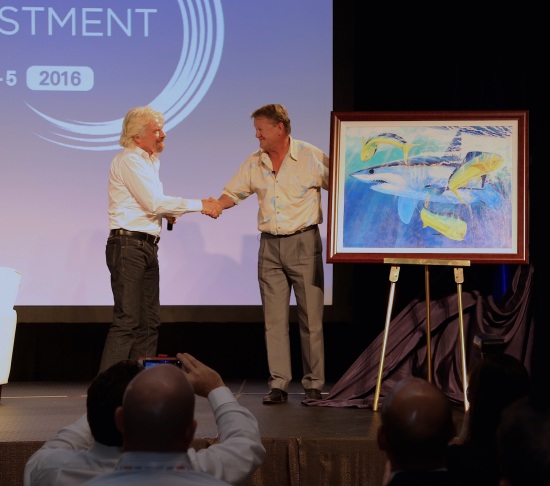
Unlike those free-swimming makos and whitetips, Wetherbee noted that hammerheads tend to stick to coastlines in the U.S. and avoid long-distance travel. Sixgills, he said, stay in deep water and don’t go very far while duskys seem attached to certain sites, but still may travel a few hundred miles.
“There are sharks without a country, moving through 10 to 15 different countries,” Wetherbee said. “They are all over the place.”
The research has important implications for shark management: knowing what countries’ waters the sharks use suggests who is responsible for managing that population and where the animals are most likely to be harvested by fishers.
“Shark populations have been overfished quite a bit. Managing these populations is going to take international cooperation,” Wetherbee said.
Mako sharks, while not classified as overfished, could still be in trouble as they are heavily targeted by commercial longliners and recreational anglers in the U.S. and elsewhere.
“Makos are in a lot of areas with tuna and swordfish,” Wetherbee said. “Everybody is after these makos because they are good to eat.”
Indeed, 13 of the 49 makos tagged by the GHRI scientists over the past four years have been caught and killed by commercial fishers. The tiger sharks, fortunately, escaped those gauntlets.
Wetherbee, Harvey and Shivji plan more shark-tagging expeditions in 2016, hoping to fit another 40 to 50 animals with satellite transmitters.
***************
Sue Cocking chronicles the Guy Harvey Outpost travel and adventure experience in regular blog posts on GuyHarveyOutpostNews.com/. For 21 years, Cocking covered the full spectrum of outdoors adventure opportunities in South Florida and beyond for the Miami Herald, including fishing, diving, hunting, paddling camping, sailing and powerboat racing. She is a certified scuba diver and holder of an IGFA women’s world fly fishing record for a 29-pound permit.
**********
Share your photos, videos and experiences with Guy Harvey Outpost by hash tagging #OutpostAttitude to all of your social media posts.
Taking the Back Country in the Blazing Mako
February 16, 2016 at 10:37 pm | Posted in Uncategorized | Leave a commentTags: backcountry fishing, Blazing Mako, Florida Bay, Guy Harvey, Guy Harvey Outpost, Islamorada, Islander Resort, Richard Black
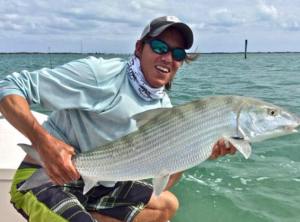 By Sue Cocking, Guy Harvey Outpost staff writer
By Sue Cocking, Guy Harvey Outpost staff writer
scocking@guyharveyoutpost.com
Even though the Guy Harvey Outpost Blazing Mako Festival and Fishing Tournament is still four months away, it’s not too early to sign up your team or start plotting a strategy for claiming $10,000 in prize money– particularly if you enter the inshore division.
The tournament date of June 18 falls squarely during the peak of the inshore fishing season in and around the Florida Keys and two days before the full moon. Catching, measuring, photographing and releasing the eligible back country species of permit, bonefish, tarpon, snook, redfish and the funfish category of shark, ladyfish, jack and trout for points, cash, and bragging rights won’t be as challenging as during other seasons of the year.
Anglers will be allowed to enter a maximum of five fish in each category using live bait, artificial lures, or fly tackle. More points will be awarded for lures and fly rod.
“This is a great time of year to catch all these species,” said seven-year veteran Keys light-tackle guide captain Richard Black, who fishes from a 17-foot, 8-inch Hells Bay Professional skiff.
Black said his strategy would be to locate small tarpon first thing in the morning in Florida Bay– likely near Snake Bight– and fish with fly rod (if the angler were capable), or with small Mir-O-Lure plugs or light jigs. Snook and redfish tend to inhabit the same territory at that time of year and likely would bite the same offerings.
Once you’ve racked up enough points for those three species, Black says step two would be to blind-cast a jig or plug for ladyfish. You could enter the larger ones in the funfish category and keep a few to hang off the skiff while anchored to attract lemon sharks to within fly-casting range.
“In a good spot with good current, you could catch five sharks on fly pretty quick,” Black said.
Then if you are lucky enough to have sufficient sunlight in mid- to late afternoon, the guide said, you could look for bonefish in Florida Bay or on the ocean side of the Upper Keys. Bonefish almost never turn down fresh shrimp, and they also are likely to bite small jigs and shrimp-patterned flies.
“I know some anglers I’d lead off with fly and switch to bait,” Black added. “You have to fish the conditions. If conditions are crappy and you have to cover more water, you would use a spinning rod.”
Black believes it will take 1,500 to 2,000 points to score a top-three finish.
Even if you don’t accumulate nearly that score, it will be more than fun to try and then you get to celebrate at the awards party at the Islander– a Guy Harvey Outpost Resort in Islamorada.
**********************
Sue Cocking chronicles the Guy Harvey Outpost travel and adventure experience in regular blog posts on GuyHarveyOutpostNews.com/. For 21 years, Cocking covered the full spectrum of outdoors adventure opportunities in South Florida and beyond for the Miami Herald, including fishing, diving, hunting, paddling camping, sailing and powerboat racing. She is a certified scuba diver and holder of an IGFA women’s world fly fishing record for a 29-pound permit.
**********
Share your photos, videos and experiences with Guy Harvey Outpost by hash tagging #OutpostAttitude to all of your social media posts.
Guy Harvey Outpost Coming to Tarpon Springs
February 15, 2016 at 5:55 pm | Posted in Uncategorized | Leave a commentTags: Anclote River, Guy Harvey, Guy Harvey Oupost, Pasco County, RV Resort, tarpon, Tarpon Springs
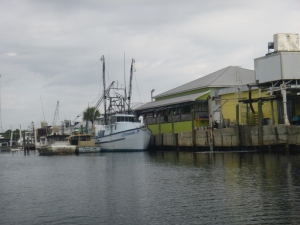 By Sue Cocking, Guy Harvey Outpost staff writer
By Sue Cocking, Guy Harvey Outpost staff writer
scocking@guyharveyoutpost.com
[Tarpon Springs, FL.–] A school of small tarpon rolled maddeningly on the surface of the Spring Bayou in the center of the Gulf Coast Florida town named for these irascible gamefish. Captain Craig Lahr and I cast live pinfish on Styrofoam floats toward the happily-frolicking school whenever it surfaced, but our baits were ignored. Lahr tried a few casts with a Deceiver-style fly, hoping its soft presentation might do the trick. But that didn’t work either.
Finally, we removed the floats and simply free-lined the pinfish in the direction the tarpon were moving. At first, nothing happened. But then my line started peeling furiously off the spinning reel, so I clicked the bail shut and quickly reeled up the slack and…..nothing — except for a dead, crushed pinfish still on the circle hook.
But then, that’s tarpon fishing wherever in the world you may pursue them.
Fortunately, tarpon are by no means the only fish to chase in and around the eponymous Tarpon Springs.
“Snook, redfish, sheepshead, flounder, black drum, jack crevalle, ladyfish, sea trout, bass, bream, speckled perch,” Lahr, a 20-year veteran Gulf Coast light-tackle guide, said as he ran out of fingers ticking them all off.
Lahr loves to fish the Anclote River, which flows for about 30 miles from a swamp in Pasco County west through Tarpon Springs to the Gulf of Mexico near the tiny town of Holiday. Depending on tide and rainfall, Lahr can maneuver his 21-foot bay boat some 15 miles upriver before the waters become too shallow to navigate. Kayaks and canoes can venture even further inland where the waters turn from salty to fresh. Nearby, there’s Lake Tarpon where Florida’s unofficial state-record largemouth bass weighing 19.6 pounds was caught by Riley Witt in 1961.
“When you get bad weather and it’s cold, you can come in here and it will be warmer and there will be fish in here,” Lahr said of the Anclote. “The river doesn’t get rough.”
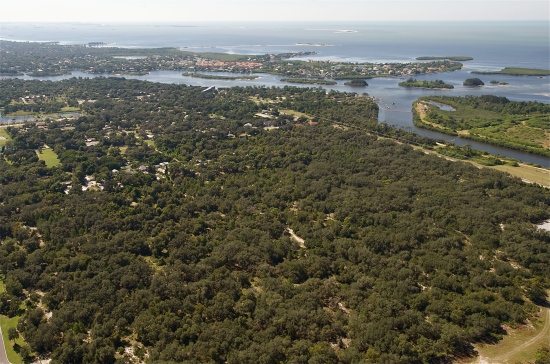
Fishing was a tad slow the day we explored the area, owing to feeble tides and passage of a cold front. But we caught and released redfish and catfish using live shrimp and pinfish, spied a large school of snook around a marina dock that was apparently afflicted with lockjaw, and of course sparred unsuccessfully with the baby tarpon.
Besides the anticipation of fish, the Anclote presented a non-stop wildlife show– ospreys cheeping from their brushy nests in the trees; flocks of pelicans gliding overhead; a great blue heron that shadowed us for a while and then managed to steal a pinfish from the live well; a herd of manatees that joined the tarpon at the Spring Bayou.
And all that was before we headed three miles offshore to picturesque Anclote Key Preserve State Park, which harbors colonies of nesting birds, pristine beaches and a historic lighthouse.
The Anclote’s working waterfront known as the Sponge Docks flows right through the middle of Tarpon Springs. It is where commercial fishers and spongers tie up their boats; throngs of tourists browse dozens of gift and antique shops; and restaurants serve authentic Greek cuisine and fresh seafood. Plenty of gamefish lurk right under those busy docks, but enticing them to bite is another story.
In the winter of 2017, visitors and residents will have a new base camp from which to explore the region: the Guy Harvey Outpost RV Resort just north of Tarpon Springs in Pasco County. Developed in conjunction with Elite Resorts, the $15 million, 46-acre project will feature 340 brick-paved RV lots and the full slate of resort-style amenities located a stone’s throw from the Anclote River and the Gulf of Mexico.
Yet one more good excuse for me to make a return trip and try to get one over on those uncooperative tarpon.
***************
Sue Cocking chronicles the Guy Harvey Outpost travel and adventure experience in regular blog posts on GuyHarveyOutpostNews.com/. For 21 years, Cocking covered the full spectrum of outdoors adventure opportunities in South Florida and beyond for the Miami Herald, including fishing, diving, hunting, paddling camping, sailing and powerboat racing. She is a certified scuba diver and holder of an IGFA women’s world fly fishing record for a 29-pound permit.
**********
Share your photos, videos and experiences with Guy Harvey Outpost by hash tagging #OutpostAttitude to all of your social media posts.
Speak Out for Your Florida Reefs
February 12, 2016 at 9:28 pm | Posted in Uncategorized | Leave a commentTags: Biscayne National Park, coral reefs, Guy Harvey, Guy Harvey Outpost, Our Florida Reefs, St. Lucie Inlet
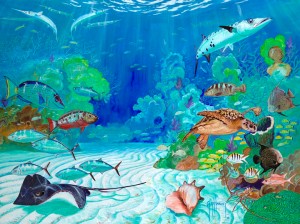
By Sue Cocking, Guy Harvey Outpost staff writer
scocking@guyharveyoutpost.com
Anglers, divers, or anyone who enjoys the ocean off Southeast Florida needs to pay close attention and get involved in a new initiative proposed by a community group called Our Florida Reefs.
This group of anglers, divers, scientists, local government officials, business owners, conservationists and others has been working for two years on 68 wide-ranging recommendations aimed at protecting the 105-mile coral reef tract extending south from St. Lucie Inlet in Martin County to just north of Biscayne National Park in Miami-Dade County. This region of Southeast Florida was targeted because, unlike Biscayne National Park and the Keys, it has no management plan in place to balance use with protection of coral reefs.
Some of the community working group’s recommendations for saving coral are non-controversial, such as installing mooring buoys and enhancing reef education in schools. But others have drawn considerable ire from user groups both online and at public meetings.
One of the proposals–N-59– would ban spear fishing using scuba gear throughout the region –except for harvesting invasive lionfish–in order to eliminate the targeting of the largest and most fertile reef fish species. Another–S-97–would reduce the annual, two-day lobster mini-season bag limit statewide from 12 to six per day and would require lobster hunters to complete an educational program in order to receive a permit. Recommendation N-146 would establish a series of marine protected areas along the Southeast Florida coast that includes no-take zones; seasonal closures to protect spawning aggregations; no-anchoring areas; and coral restoration areas.
You– the ocean user– have until March 1 to review and comment on these proposals. Then they will be forwarded to local, state and federal agencies for action.
You can provide comments on the Our Florida Reefs website or at public meetings this month from noon to 2 p.m. and 6 p.m. to 8 p.m. Feb. 16 at Holiday Park Social Center, 1150 G. Harold Martin Dr., Fort Lauderdale; Feb. 17 at Newman Alumni Center at University of Miami, 6200 San Amaro Dr., Coral Gables; and Feb.18 at Kovens Conference Center, FIU/Biscayne Bay Campus, 3000 NE 151 St., North Miami.
If this really is a community planning process and not being executed at the behest of the Florida Department of Environmental Protection or the National Oceanic and Atmospheric Administration, then what you say counts. Speak up.
****************
Sue Cocking chronicles the Guy Harvey Outpost travel and adventure experience in regular blog posts on GuyHarveyOutpostNews.com/. For 21 years, Cocking covered the full spectrum of outdoors adventure opportunities in South Florida and beyond for the Miami Herald, including fishing, diving, hunting, paddling camping, sailing and powerboat racing. She is a certified scuba diver and holder of an IGFA women’s world fly fishing record for a 29-pound permit.
**********
Share your photos, videos and experiences with Guy Harvey Outpost by hash tagging #OutpostAttitude to all of your social media posts.
Blog at WordPress.com.
Entries and comments feeds.